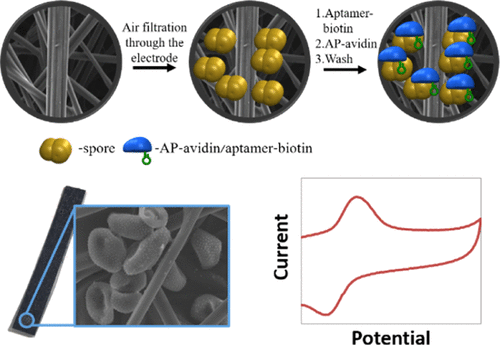Our official English website, www.x-mol.net, welcomes your feedback! (Note: you will need to create a separate account there.)
Rapid Collection and Aptamer-Based Sensitive Electrochemical Detection of Soybean Rust Fungi Airborne Urediniospores
ACS Sensors ( IF 8.9 ) Pub Date : 2021-01-28 , DOI: 10.1021/acssensors.0c02452 Vadim Krivitsky 1 , Eran Granot 1 , Yoav Avidor 2 , Ella Borberg 1 , Ralf T. Voegele 3 , Fernando Patolsky 1, 4
ACS Sensors ( IF 8.9 ) Pub Date : 2021-01-28 , DOI: 10.1021/acssensors.0c02452 Vadim Krivitsky 1 , Eran Granot 1 , Yoav Avidor 2 , Ella Borberg 1 , Ralf T. Voegele 3 , Fernando Patolsky 1, 4
Affiliation

|
Plants are the central source of food for humans around the world. Unfortunately, plants can be negatively affected by diverse kinds of diseases that are responsible for major economic losses worldwide. Thus, monitoring plant health and early detection of pathogens are essential to reduce disease spread and facilitate effective management practices. Various detection approaches are currently practiced. These methods mainly include visual inspection and laboratory tests. Nonetheless, these methods are labor-intensive, time-consuming, expensive, and inefficient in the early stages of infection. Thus, it is extremely important to detect diseases at the early stages of the epidemic. Here, we would like to present a fast, sensitive, and reliable electrochemical sensing platform for the detection of airborne soybean rust spores. The suspected airborne soybean rust spores are first collected and trapped inside a carbon 3D electrode matrix by high-capacity air-sampling means. Then, a specific biotinylated aptamer, suitable to target specific sites of soybean rust spores is applied. This aptamer agent binds to the surface of the collected spores on the electrode. Finally, spore-bound aptamer units are incubated with a streptavidin–alkaline phosphatase agent leading to the enzymatic formation of p-nitrophenol, which is characterized by its unique electrochemical properties. Our method allows for the rapid (ca. 2 min), selective, and sensitive collection and detection of soybean rust spores (down to the limit of 100–200 collected spores per cm2 of electrode area). This method could be further optimized for its sensitivity and applied to the future multiplex early detection of various airborne plant diseases.
中文翻译:

大豆锈病真菌空生乌头孢子孢子的快速收集和基于适体的灵敏电化学检测
植物是世界各地人类食物的主要来源。不幸的是,植物会受到各种疾病的不利影响,这些疾病造成了全球范围内的重大经济损失。因此,监测植物健康和早期发现病原体对于减少疾病传播和促进有效的管理实践至关重要。当前实践了各种检测方法。这些方法主要包括外观检查和实验室测试。然而,这些方法在感染的早期阶段是劳动密集型的,费时的,昂贵的并且效率低下的。因此,在流行病的早期发现疾病非常重要。在这里,我们想提出一种快速,灵敏和可靠的电化学传感平台,用于检测航空大豆锈病孢子。首先,通过大容量空气采样装置收集可疑的机载大豆锈病孢子,并将其捕获在碳3D电极基质中。然后,应用适合于靶向大豆锈菌孢子特定部位的特定生物素化适体。该适体试剂结合到电极上收集的孢子的表面。最后,将结合孢子的适体单位与链霉亲和素碱性磷酸酶试剂一起孵育,从而导致酶的形成。对硝基苯酚,其特征在于其独特的电化学性能。我们的方法可以快速(约2分钟),选择性,灵敏地收集和检测大豆锈菌孢子(每厘米2电极面积可收集到100-200个孢子的极限)。可以进一步优化该方法的灵敏度,并将其应用于未来多种机载植物病害的多重早期检测。
更新日期:2021-03-26
中文翻译:

大豆锈病真菌空生乌头孢子孢子的快速收集和基于适体的灵敏电化学检测
植物是世界各地人类食物的主要来源。不幸的是,植物会受到各种疾病的不利影响,这些疾病造成了全球范围内的重大经济损失。因此,监测植物健康和早期发现病原体对于减少疾病传播和促进有效的管理实践至关重要。当前实践了各种检测方法。这些方法主要包括外观检查和实验室测试。然而,这些方法在感染的早期阶段是劳动密集型的,费时的,昂贵的并且效率低下的。因此,在流行病的早期发现疾病非常重要。在这里,我们想提出一种快速,灵敏和可靠的电化学传感平台,用于检测航空大豆锈病孢子。首先,通过大容量空气采样装置收集可疑的机载大豆锈病孢子,并将其捕获在碳3D电极基质中。然后,应用适合于靶向大豆锈菌孢子特定部位的特定生物素化适体。该适体试剂结合到电极上收集的孢子的表面。最后,将结合孢子的适体单位与链霉亲和素碱性磷酸酶试剂一起孵育,从而导致酶的形成。对硝基苯酚,其特征在于其独特的电化学性能。我们的方法可以快速(约2分钟),选择性,灵敏地收集和检测大豆锈菌孢子(每厘米2电极面积可收集到100-200个孢子的极限)。可以进一步优化该方法的灵敏度,并将其应用于未来多种机载植物病害的多重早期检测。



























 京公网安备 11010802027423号
京公网安备 11010802027423号